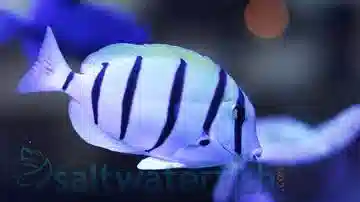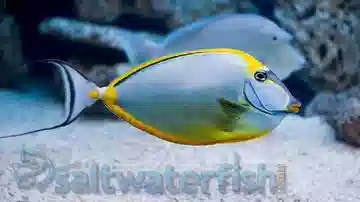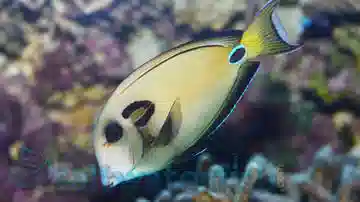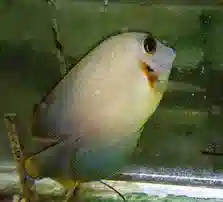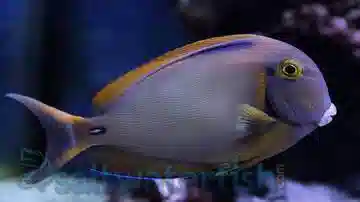Black Spot Tang
Acanthurus bariene
(0 Reviews)
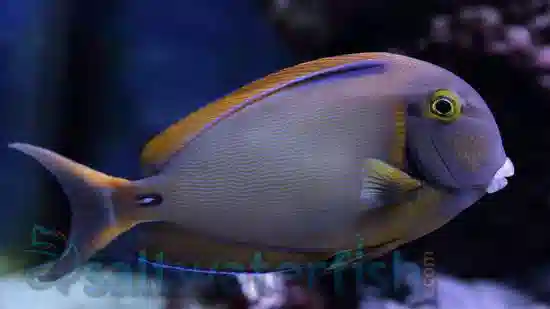
Black Spot Tang
Acanthurus bariene
(0 Reviews)
{{ item.name }}
Size: {{ item.extra_field_3 }}
${{ getFormattedPrice(item.saleprice) }} ${{ getFormattedPrice(item.price) }}
To join the waiting list, click here
Free Shipping
With
$199.00
or more in Marine Life.
More details...
Black Spot Tang Care Facts
| Care Level: | Easy |
|---|---|
| Temperament: | Peaceful |
| Diet: | Omnivore |
| Reef Safe: | Yes |
| Minimum Tank Size: | 360 gallons |
| Max Size: | 20 inches |
Black Spot Tang (Acanthurus bariene) - A Comprehensive Guide for Saltwater Marine Aquariums
This comprehensive guide provides essential information for saltwater marine aquarium enthusiasts interested in the care and maintenance of the Black Spot Tang (Acanthurus bariene). Covering various aspects of their natural habitat, reef compatibility, size, lifespan, dietary requirements in captivity, aquaculture availability, sexual dimorphism, symbiotic relationships, juvenile versus adult coloration, temperament, tank specifications, and precise water conditions, this guide will assist both novice and experienced aquarists in successfully keeping this striking species in a home aquarium.
Habitat of the Black Spot Tang (Acanthurus bariene):
The Black Spot Tang, scientifically known as Acanthurus bariene, is native to the tropical waters of the Indo-Pacific region. They are commonly found in coral reefs, lagoons, and coastal areas with rich coral growth. These fish are known for their distinctive black spot near the caudal peduncle, which gives them their common name.
Reef Compatibility of the Black Spot Tang
The Black Spot Tang is considered reef-safe, making it a desirable addition to reef aquariums. They exhibit herbivorous behavior by grazing on algae growth, which can benefit the overall health of a reef system. However, caution should be exercised when introducing them to a reef tank with particularly delicate or rare coral species, as they may occasionally nip at coral polyps or sessile invertebrates.
Size of Black Spot Tangs
Black Spot Tangs are known for their moderate size. When fully grown, they typically reach 20 inches (40 to 50 centimeters). Considering their adult size when planning an aquarium setup is essential, as they require ample swimming space.
How Long Does the Black Spot Tang Live?
With proper care and a suitable environment, Black Spot Tangs can live for a considerable period in captivity. Their lifespan commonly ranges from 5 to 10 years or more.
What Should You Feed a Black Spot Tang?
Black Spot Tangs are herbivorous and primarily feed on algae in their natural habitat. In captivity, their diet should consist mainly of:
- Algae Sheets: Offer high-quality algae sheets or seaweed clips designed for herbivorous fish. These should be a staple in their diet.
- Herbivore Pellets: High-quality commercial herbivore pellets can be provided to supplement their diet and ensure they receive essential nutrients.
- Frozen Foods: Occasional offerings of frozen foods like brine shrimp, mysis shrimp, and other small meaty items can be included for dietary variety.
- Nori Seaweed: Nori sheets can be attached to a clip and placed in the aquarium to mimic their natural grazing behavior.
The Black Spot Tang's Availability through Aquaculture
Black Spot Tangs are not commonly available through aquaculture. Most specimens in the aquarium trade are sourced from the wild. When acquiring Black Spot Tangs, purchasing them from reputable suppliers who adhere to ethical and sustainable collection practices to minimize the impact on wild populations is essential.
Sexual Dimorphism of the Black Spot Tang
Sexual dimorphism in Black Spot Tangs is not easily discernible through physical characteristics, making it challenging to differentiate between males and females based on appearance alone.
Is the Black Spot Tang Symbiotic?
Black Spot Tangs often form symbiotic relationships with cleaner fish and shrimp in their natural habitat. Cleaner species help keep their skin free from parasites by feeding on them. Replicating this relationship in captivity is possible, and some cleaner species can coexist peacefully with Black Spot Tangs, but compatibility should be monitored carefully.
Juvenile vs. Adult Coloration of the Black Spot Tang
Juvenile Black Spot Tangs often display more vibrant and contrasting coloration than adults. They typically exhibit a yellow to golden body color with a prominent black spot near the tail. As they mature, their coloration may become less intense, with some individuals developing a bluish hue.
Compatibility of the Black Spot Tang
When considering a Black Spot Tang for your saltwater aquarium, compatibility with other tank inhabitants is vital for maintaining a harmonious environment.
The Black Spot Tang's Personality
Black Spot Tangs are generally peaceful and docile, with a low likelihood of displaying aggression towards other tank mates. However, they may become territorial when confined to other tangs or similar fish species. Provide ample swimming space and suitable hiding spots to mitigate potential territorial behavior.
Suitable Tank Mates for the Black Spot Tang
Here are five compatible tank mates that can potentially coexist peacefully with Black Spot Tangs:
- Yellow Tang (Zebrasoma flavescens): Yellow Tangs are closely related and often coexist peacefully, provided adequate space, and no territorial disputes exist.
- Clownfish (Amphiprion spp.): Clownfish are generally compatible with Black Spot Tangs, and their symbiotic relationship with anemones adds visual interest to the tank.
- Chromis (Chromis spp.): Chromis species are schooling fish that can be kept with Black Spot Tangs, creating a dynamic and visually appealing display.
- Firefish (Nemateleotris spp.): Firefish are peaceful and can coexist with Black Spot Tangs, provided they are hiding places to retreat to.
- Blennies (Blenniidae): Certain blenny species, such as the Lawnmower Blenny (Salarias fasciatus), share a similar herbivorous diet with Black Spot Tangs and can be suitable tank mates.
Tank Requirements: for the Black Spot Tang
Creating an ideal environment is essential for the well-being of Black Spot Tangs. Here are specific tank requirements to consider:
- Minimum Aquarium Size: A tank with a minimum capacity of 360 gallons is recommended to accommodate the swimming space these tangs require. Larger tanks are even better, providing more room for the tang to explore.
- Aquascaping: Incorporate plenty of live rock structures and caves to provide hiding spots and territory for the tang. The rockwork should also include ample algae growth for grazing.
- Filtration: Utilize a robust filtration system to maintain water quality. A protein skimmer can be beneficial for removing organic waste.
- Water Conditions:
- pH: Maintain a stable pH level between 8.1 and 8.4.
- Salinity: Keep the salinity level in the range of 1.020 to 1.025.
- Water Temperature: Maintain a water temperature of 74°F to 78°F (23°C to 26°C).
- Water Flow: Provide moderate water flow to mimic their natural habitat conditions.
Other Common Names for the Black Spot Tang
The Black Spot Tang is also known as the Black Spot Surgeonfish, Bariene Tang, and many others.
Why People Should Buy the Black Spot Tang from Saltwaterfish.com:
Purchasing a Black Spot Tang from reputable suppliers like Saltwaterfish.com ensures you acquire a healthy and ethically sourced specimen. These suppliers prioritize the well-being of marine life and follow responsible and sustainable practices. Supporting ethical suppliers benefits the aquarist and contributes to the conservation of marine ecosystems and the reduction of the aquarium trade's impact on wild populations.
In conclusion, with its distinctive black spot and herbivorous behavior, the Black Spot Tang is a captivating addition to saltwater marine aquariums. By adhering to the guidelines outlined in this comprehensive guide and sourcing these tangs from ethical suppliers, aquarists can enjoy the presence of this remarkable species while promoting responsible and sustainable practices within the hobby.
Currently Black Spot Tang does not have any reviews.


